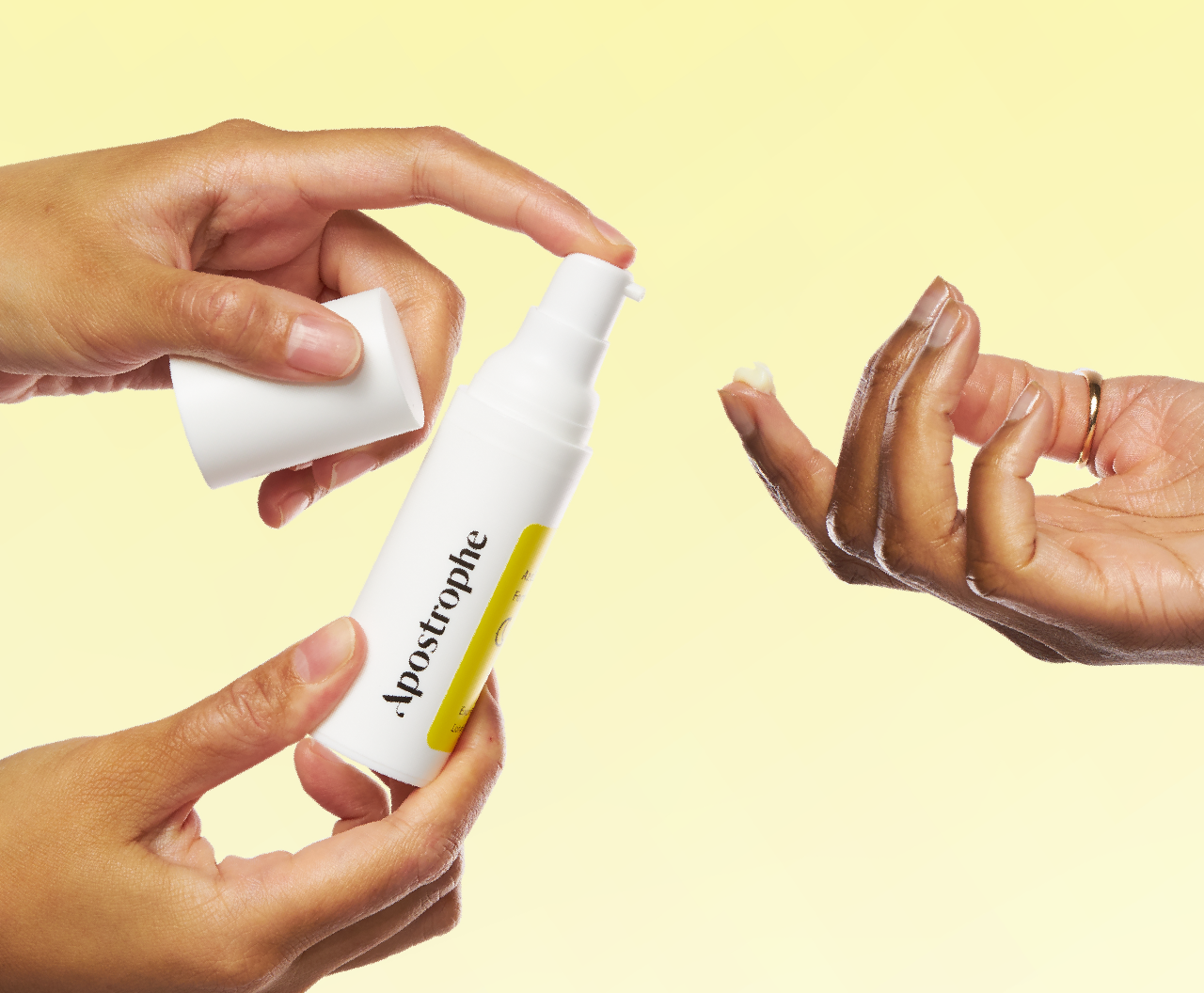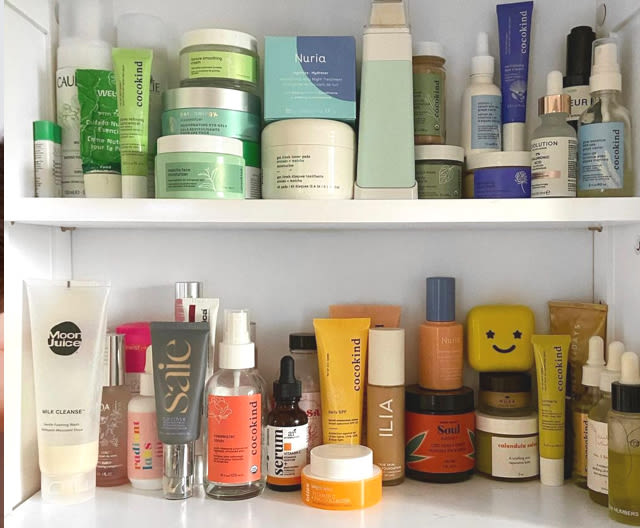Education
Best acne spot treatments


SHARE
Education
Best acne spot treatments
Medically reviewed by Katelyn Hagerty FNP
Written by Apostrophe Team
Last updated 4/1/2024
You feel it before it even breaks the surface–those giant pimples that seem to take over the reflection you see in the mirror.
And before your acne is at its worst, you’re brainstorming ways to annihilate it.
Spot treatments for acne are marketed as a way to treat pimples one at a time. But that’s not always the best way to treat acne.
Your desire to eliminate that one pesky pimple, in particular, is understandable, yet knowing how to prevent future breakouts is also valuable.
What Is Acne?
We don’t need to tell you what acne looks like—you wouldn’t be seeking acne treatment if you didn’t already recognize pimples for what they are. But acne isn’t only caused by oily skin.
In fact, pimples are caused by a complex relationship between sebum, hormones, genetics, dead skin cells (follicular hyperkeratinization), the bacteria known as Propionibacterium acnes (or Cutibacterium acnes) and inflammation.
Before you even see a pimple, these factors are at work setting the stage for one or several acne lesions.
Your menstrual cycle, UV radiation, obesity, stress, diet, sleep, smoking, cosmetics, medication, and hormonal disorders can all aggravate one or more of these factors, leading to acne breakouts.
Using a spot treatment for acne can help if your breakouts are infrequent, and you only see a pimple or two.
Spot treatments for acne are especially helpful before a date or other event, and when you want a single zit gone.
Read on for info on the best spot treatment for acne and elevate your total skin care knowledge.
Spot Treatment for Acne Lesions
When you’re met with a glaring red zit you want to get rid of, what you’re likely hoping to do is reduce inflammation (make it smaller, if not completely gone), dry it out, and reduce redness.
Look for ingredients that can help you get rid of your pimple faster, and at least make it less of an eyesore as it heals.
First: Don’t pop it. Popping and picking at a pimple will make it worse. It will take longer to heal and could increase your risk of scarring, according to the .
If your pimple is red and inflamed, it might hurt. Applying ice to it can reduce redness and pain, and may bring down some of the swelling.
Benzoyl Peroxide
One ingredient to for in acne spot treatments is benzoyl peroxide. It can reduce bacteria and the clogging of pores, and you’ll frequently find it in over the counter acne treatments.
One of the possible side effects is dry skin, but when you’re looking for a spot treatment to cover or heal a large pimple, dry skin is often worth it.
Tea tree oil is an essential oil that’s been shown to have similar efficacy to benzoyl peroxide. It can reduce the number of acne lesions and reduce inflammation.
Alpha-Hydroxy Acids
Alpha-hydroxy acids may also be present in over the counter acne spot treatments. AHAs include glycolic, lactic, and citric acid which can work to break down the dead skin cells that clog pores.
One beta-hydroxy acid, salicylic acid, is found in numerous acne spot treatments and cleansers. While it can cause peeling, it stimulates natural exfoliation and helps prevent clogged pores.
Corticosteroid Injections
Corticosteroid injections can be used by dermatologists for only the most extreme cystic acne spot treatments.
In these instances, a healthcare professional injects medicine directly into the cystic pimple to help speed healing.
What you’ll notice about most of these spot treatment ingredients is that they are largely preventative.
While some may help reduce inflammation or contain pigmentation to cover a pimple, there isn’t much evidence that they’ll speed the healing of current acne lesions.
If you do have a large pimple that doesn’t seem to go away, the American Academy of Dermatology Association recommends waiting four to six weeks for the acne to heal before becoming alarmed and contacting a healthcare professional.
However, if you feel you’re in need of severe cystic acne spot treatment, a quick visit for a corticosteroid injection can help speed healing and reduce your chances of scarring.
For more cases, you can likely reduce the redness and inflammation of a single pimple with a spot treatment on your own. Your best bet, too, is to also prevent future active breakouts.
Getting Ahead of Acne Breakouts
Treating the cause of your acne breakouts is likely the most effective way of preventing them and the emergency need to spot treat one giant zit.
First, consider if stress, diet, or sleep might be at play. These are factors within your control, and taking good care of your overall health can promote healthier skin.
There are numerous products on the market that can help you get ahead of your acne. Here are some treatments that can help prevent future breakouts:
Retinoids
Tretinoin, adapalene, and other retinoids are used to prevent clogged pores and .
They are highly effective at decreasing the number of acne lesions, by as much as 70%, according to research.

PRESCRIPTION TRETINOIN
Target acne, dark spots, and signs of aging with this science-backed ingredient.
Found in numerous acne treatments, retinoids are often suggested as a monotherapy (where you don’t need anything else) for mild acne, or to be used in conjunction with other products in the case of moderate to severe acne.
Azelaic Acid
Azelaic acid may be recommended as the first-line treatment for acne, meaning it’s the popular go-to, or the first thing you might want to try.
One of the big selling points for this active ingredient is it’s safe for women who are pregnant, breastfeeding, or who may become pregnant.
Oral Contraceptives
It’s long been known that birth control pills can help manage acne by regulating your hormones.
Several studies have indicated such, and the of using oral contraceptives (birth control pills) can be particularly attractive when you know your acne worsens at certain points during your cycle.
Systemic Antibiotics
For severe acne, a doctor may prescribe oral antibiotics in conjunction with topical products. They’re generally used with topical products in order to prevent antibiotic resistance.
What Is the Best Spot Treatment for Acne?
If acne is a disease, then a pimple is a symptom, and as with most instances, treating a symptom doesn’t always mean a full cure.
Preventing breakouts by addressing the causes of acne can help keep your skin clear for the long run, and if you do get a pimple, using a spot treatment for acne can provide a quick fix.
Shop this post

Tretinoin

Finacea (azelaic acid)
Like what you just read? Sign up for our email list to get the scoop on skincare science delivered straight to your inbox.

Education
What is milia?
What is milia? Today, we’re jumping into one type of bump that you may have heard about most commonly in infants — milia.
Read More
Education
Best moisturizer for acne-prone skin
If you have combination acne-prone skin, figuring out which moisturizer is best for your skin might be tough. In this guide, we break down the best moisturizer for combination, acne-prone skin.
Read More
Education
How to build a face care routine
As you get into skincare, it might seem overwhelming, especially trying to figure out the order you're supposed to apply products in. Below, we detail how to build a face care routine for your skin!
Read More